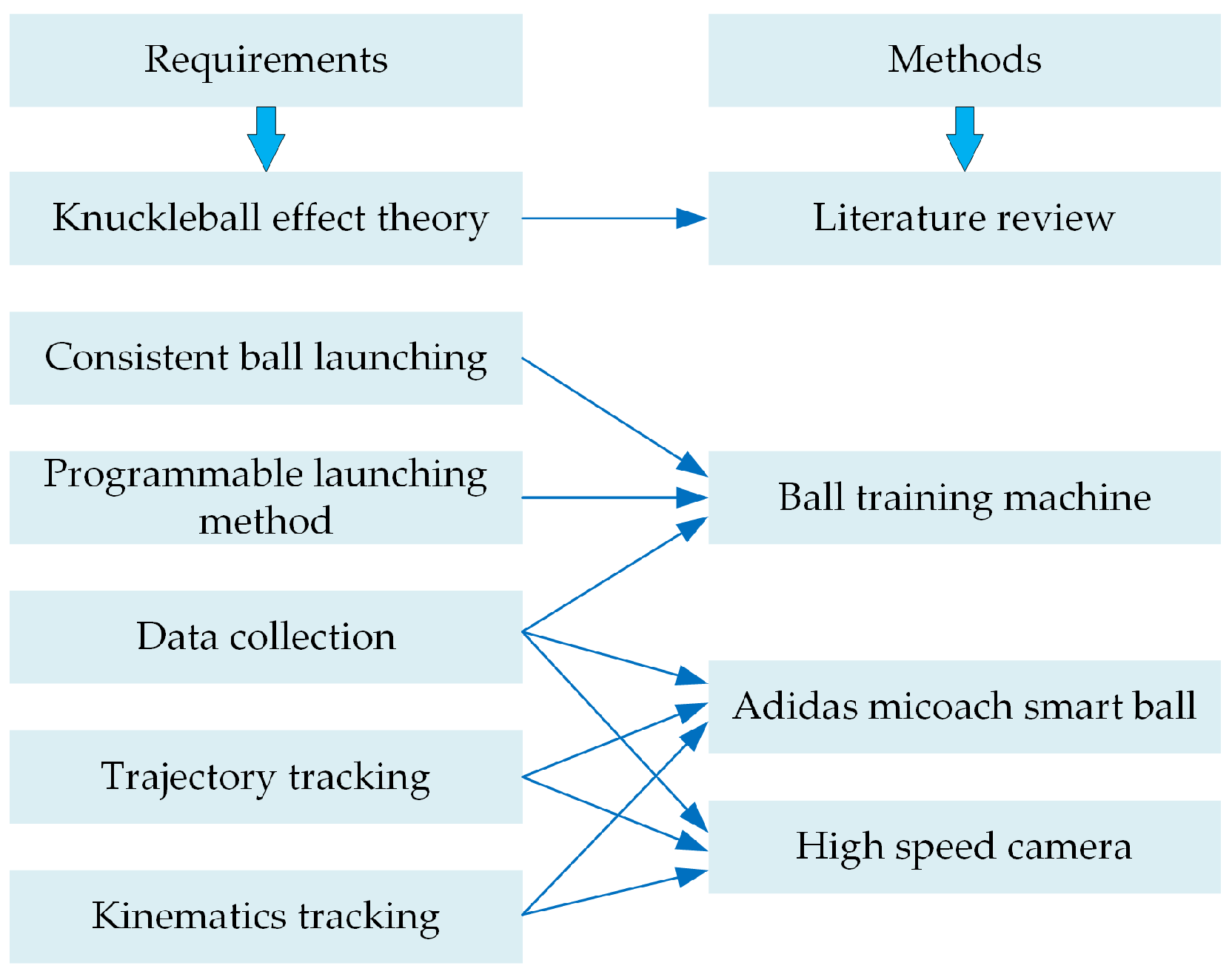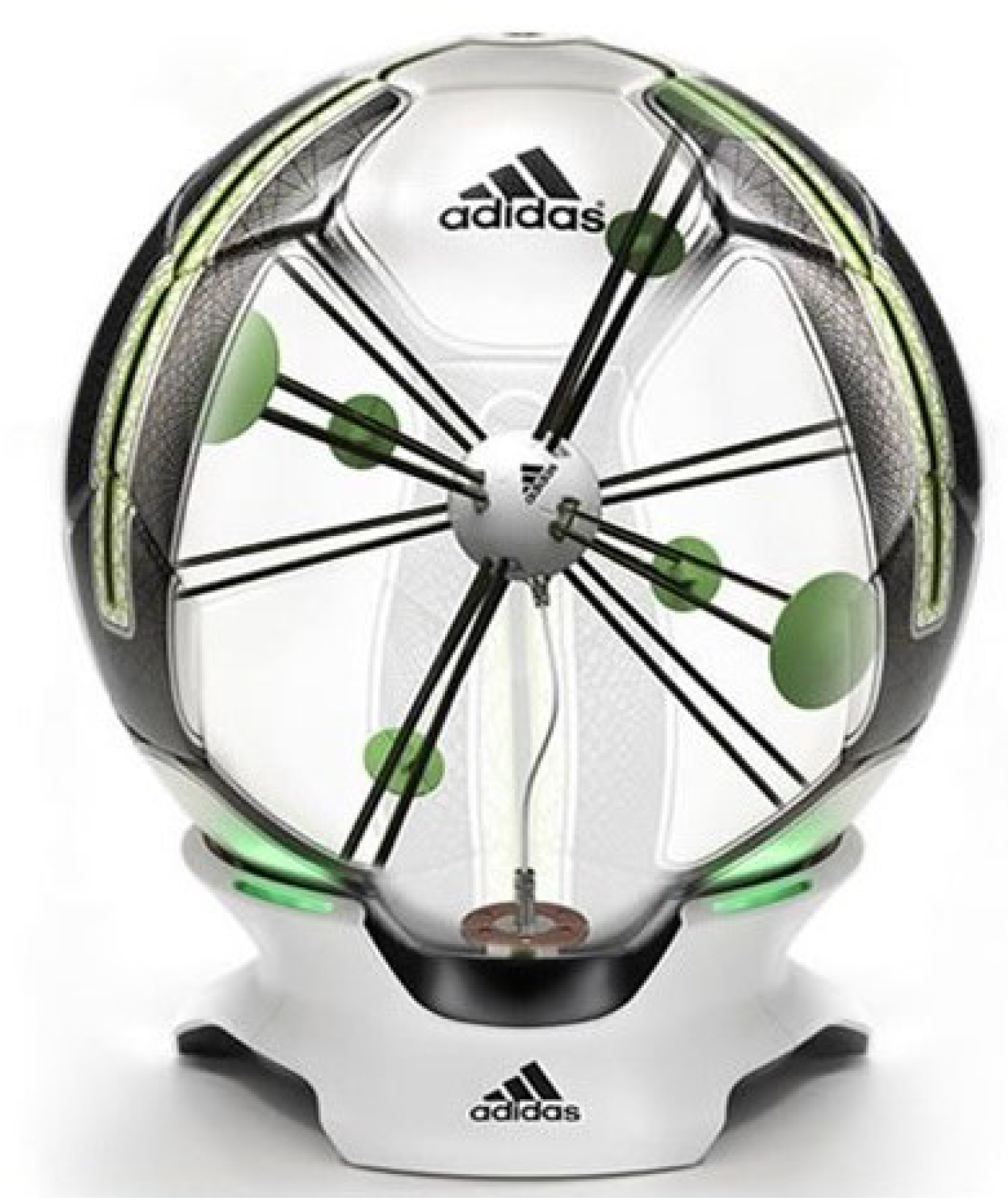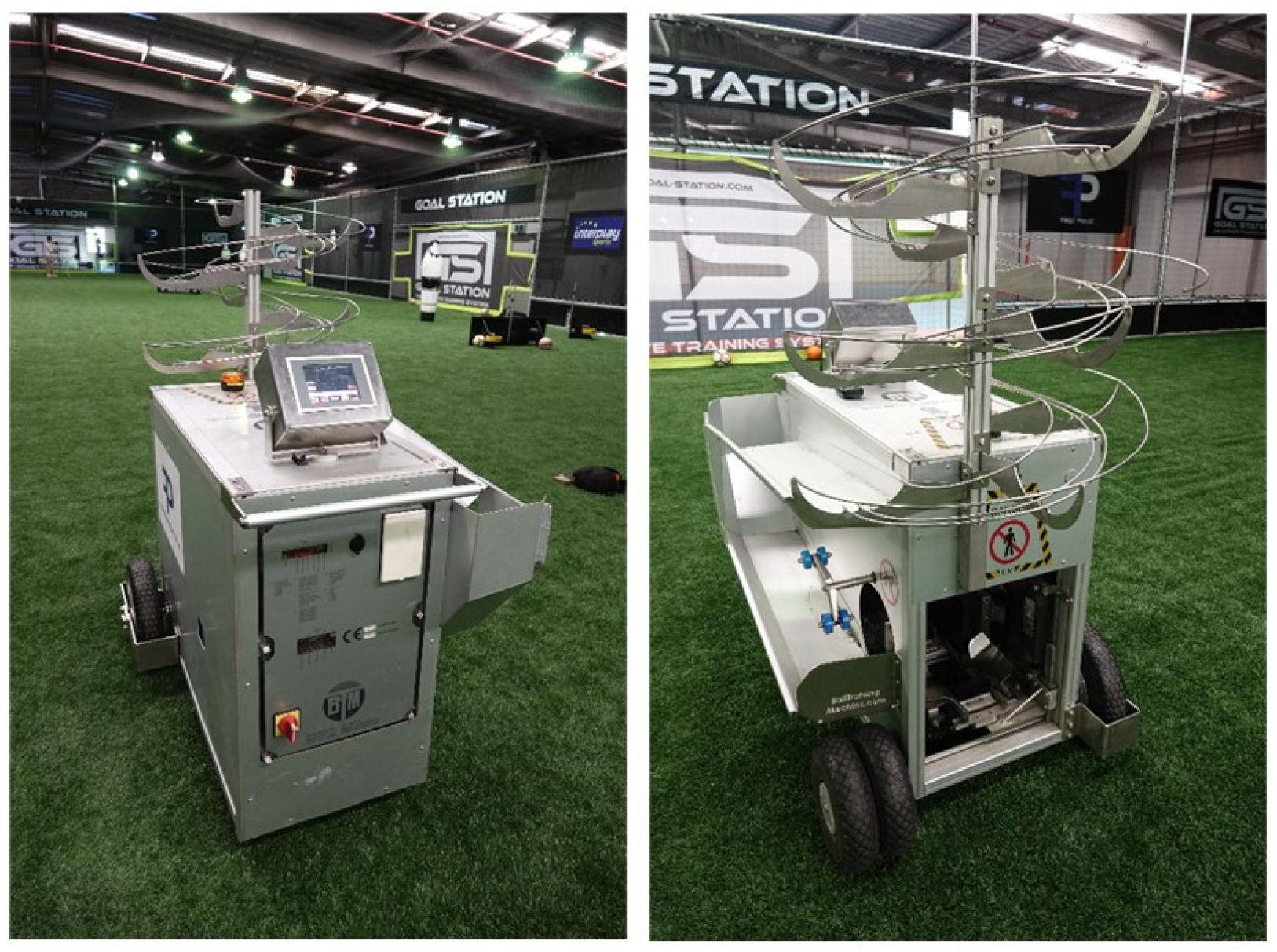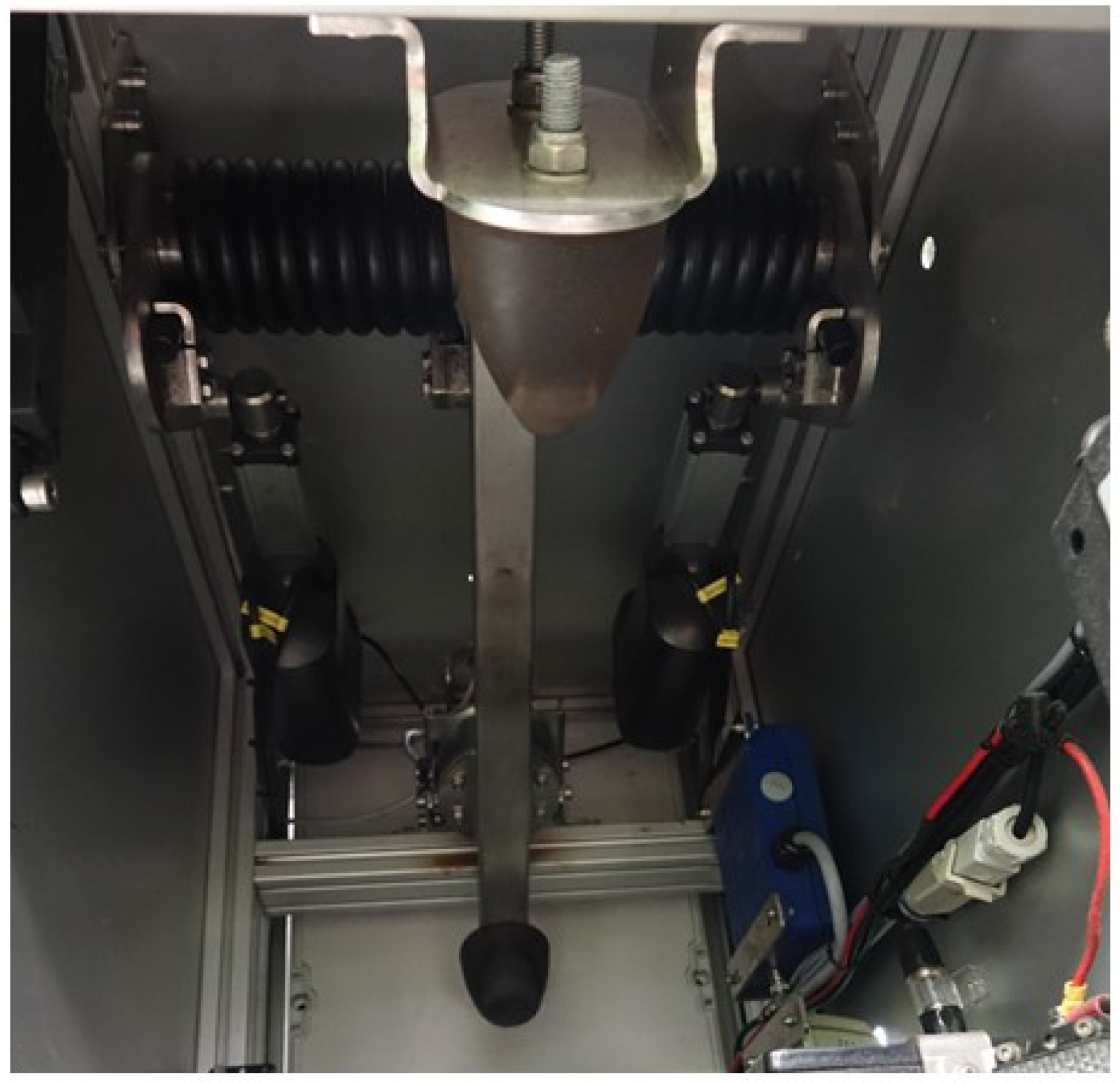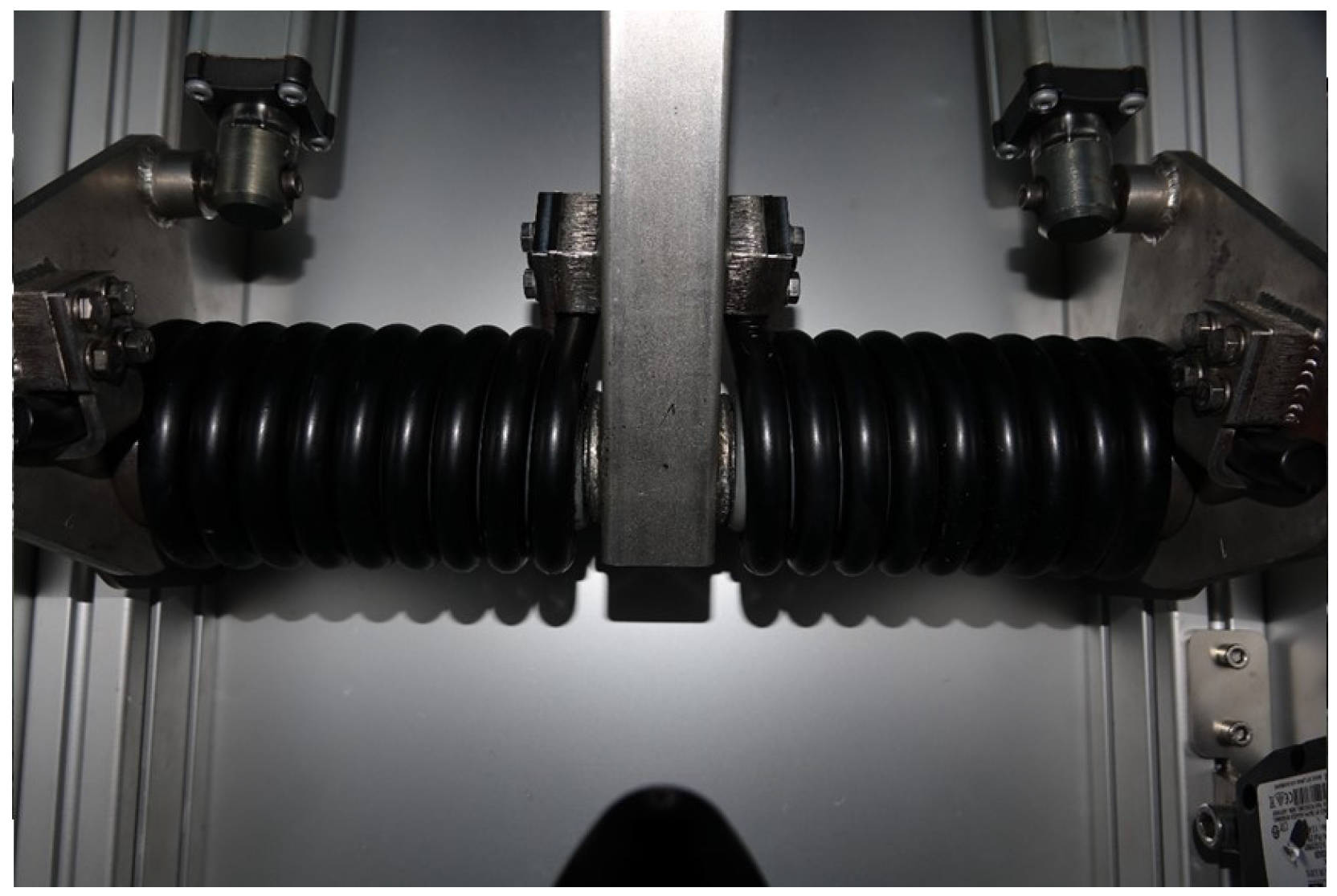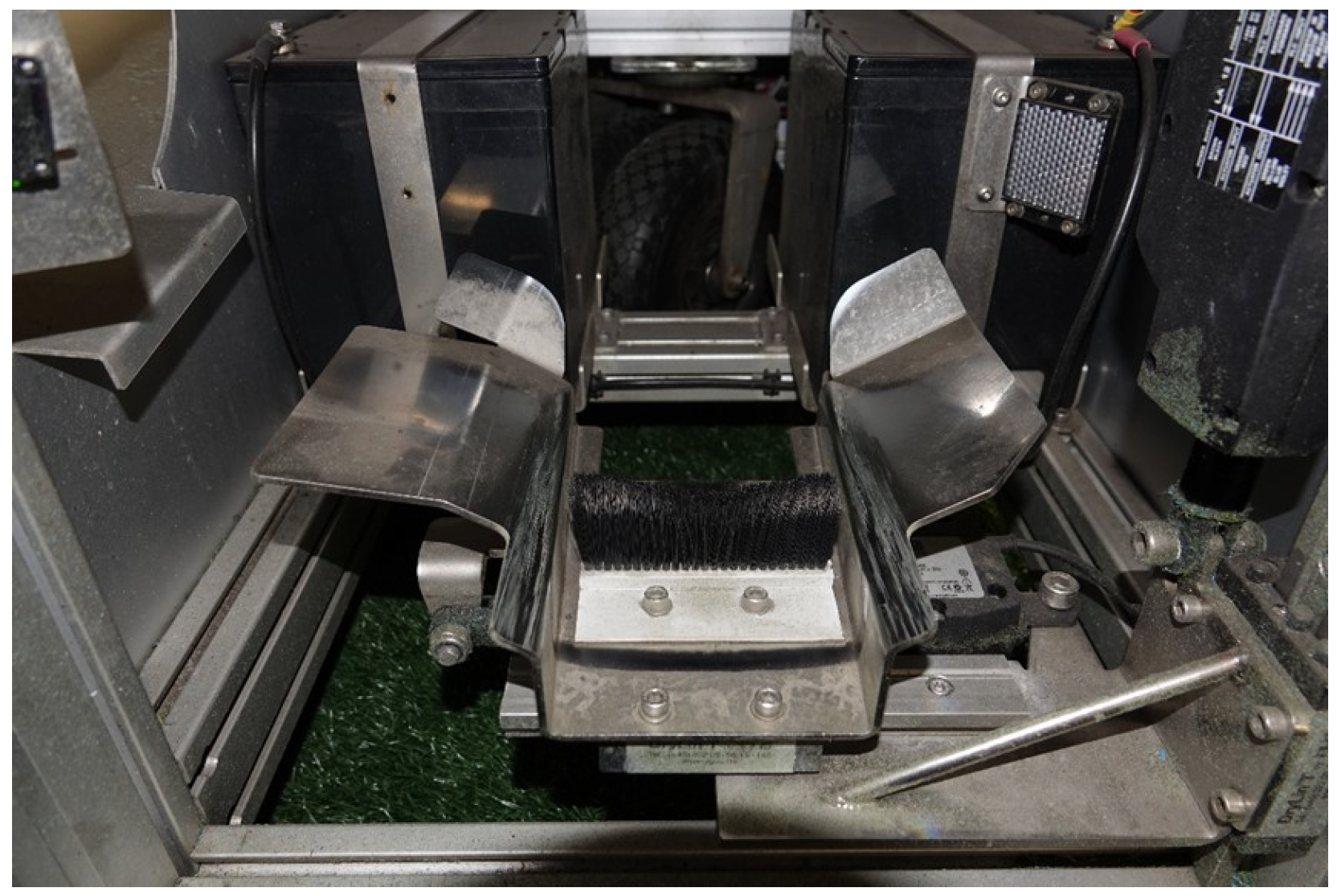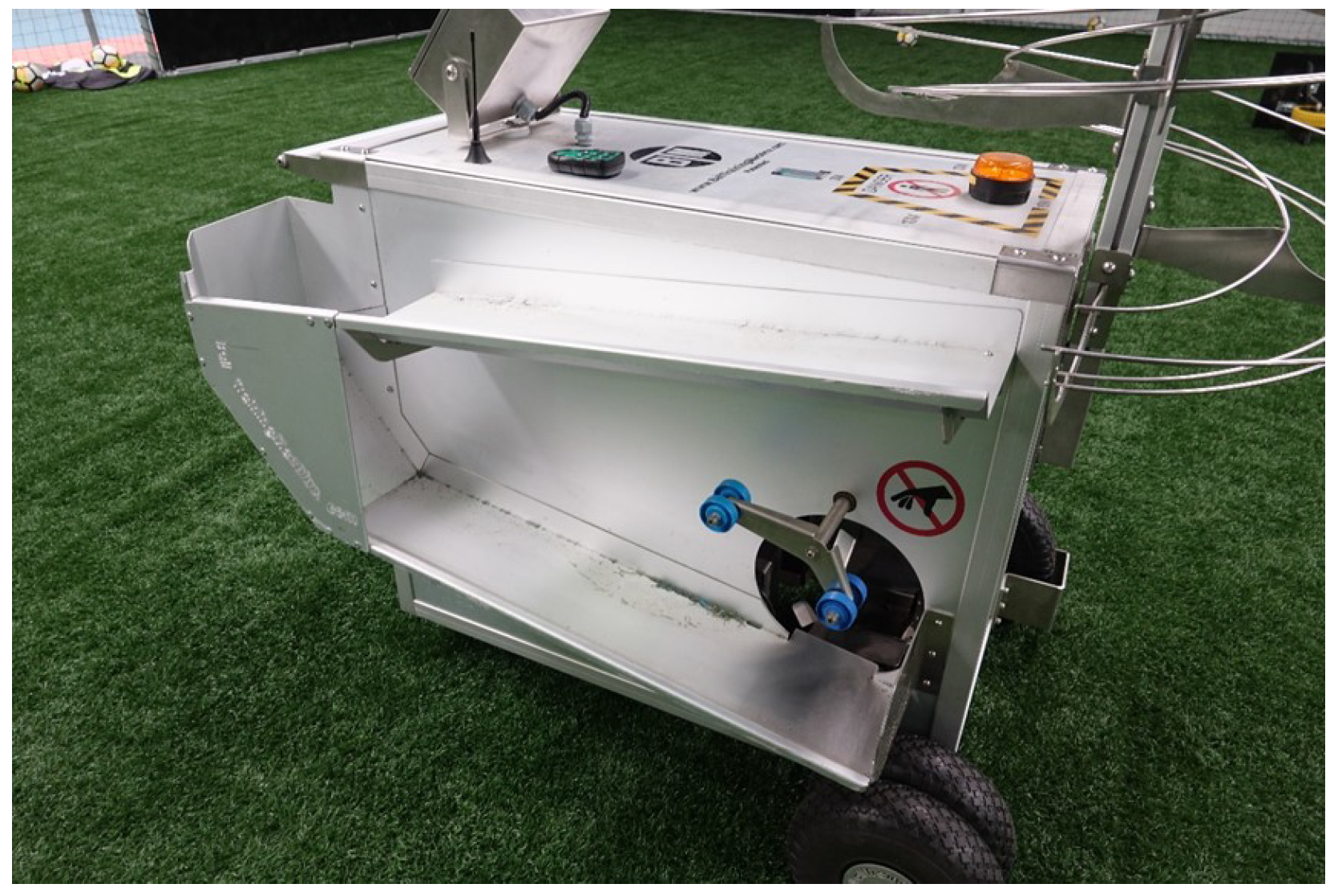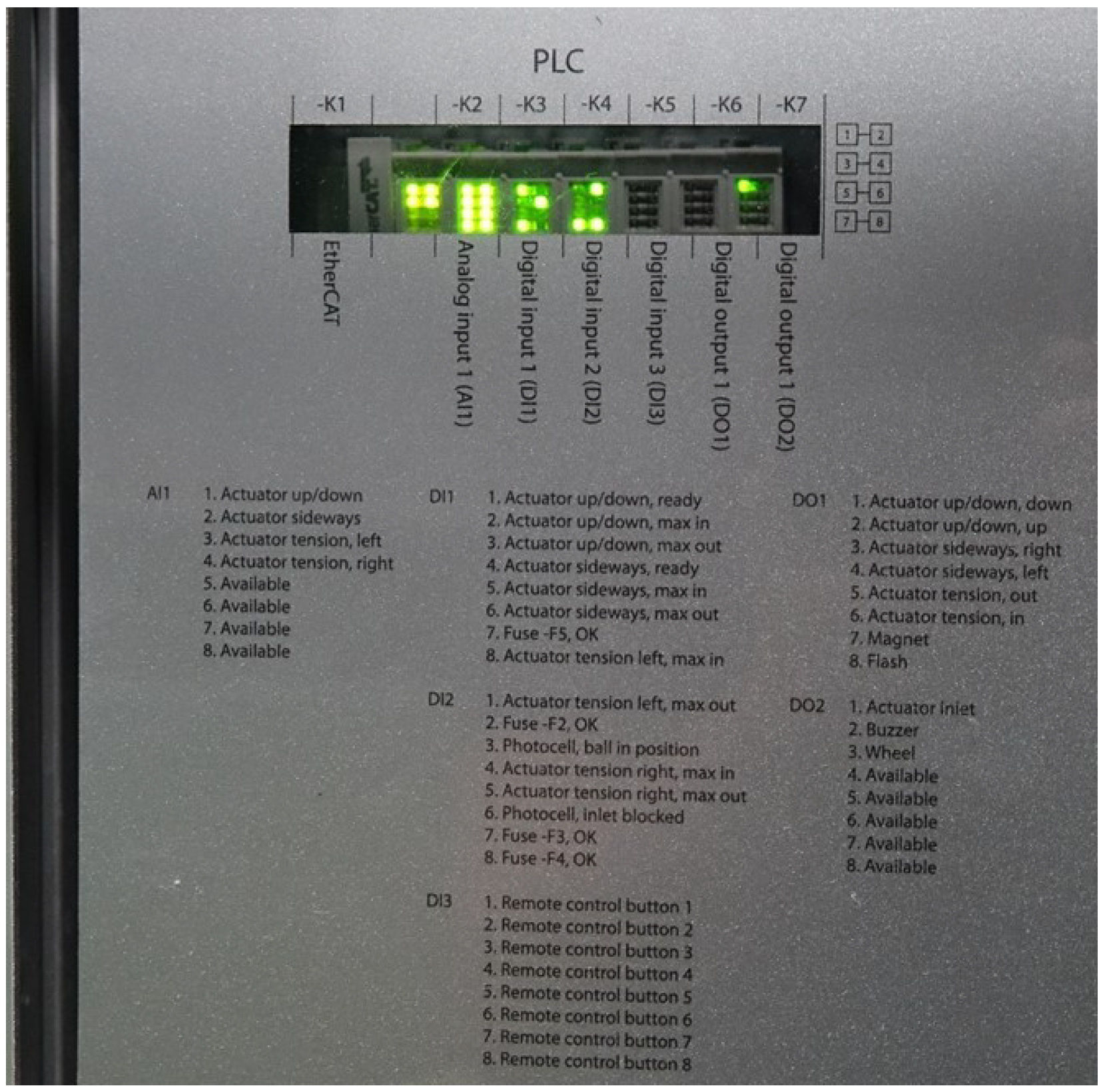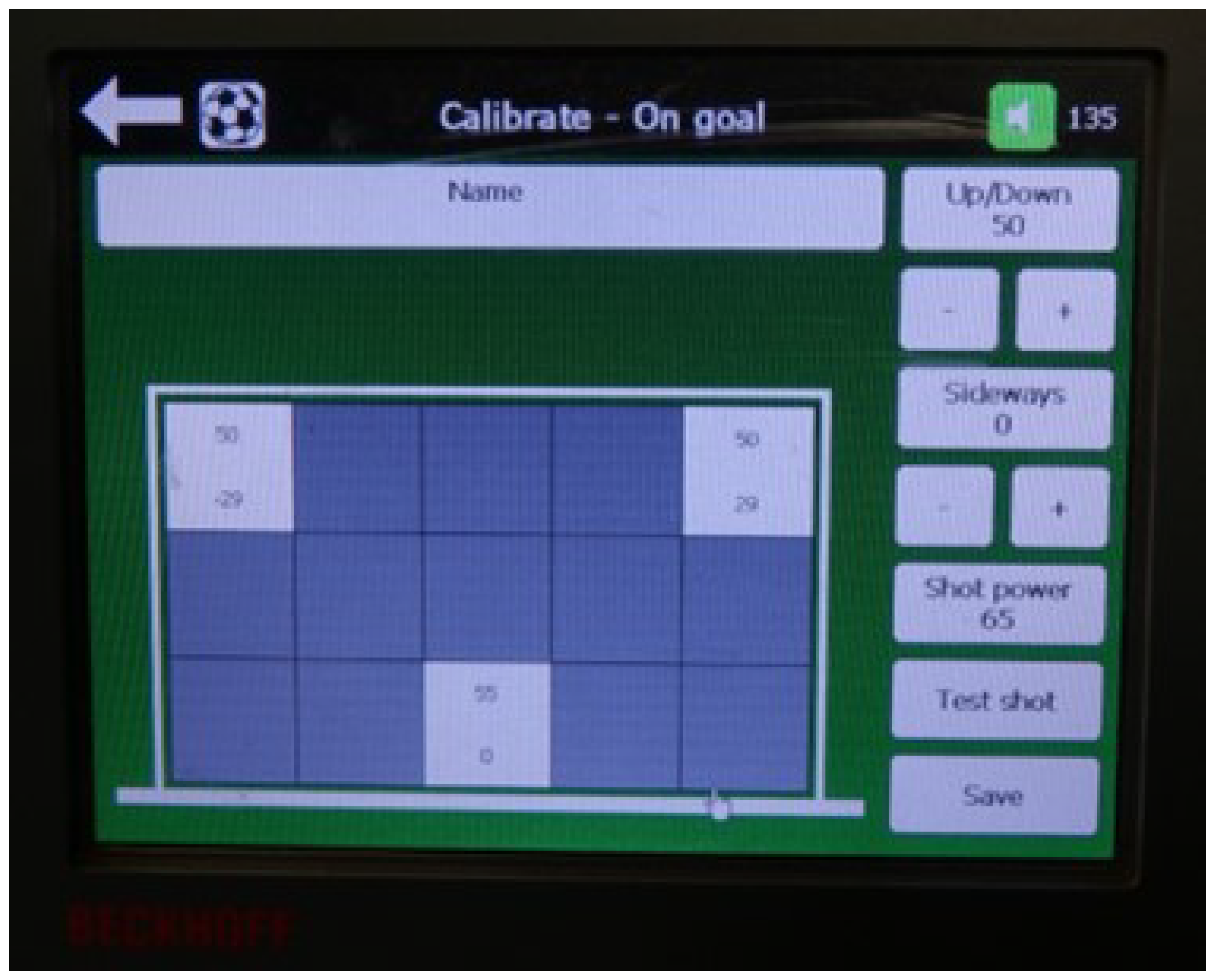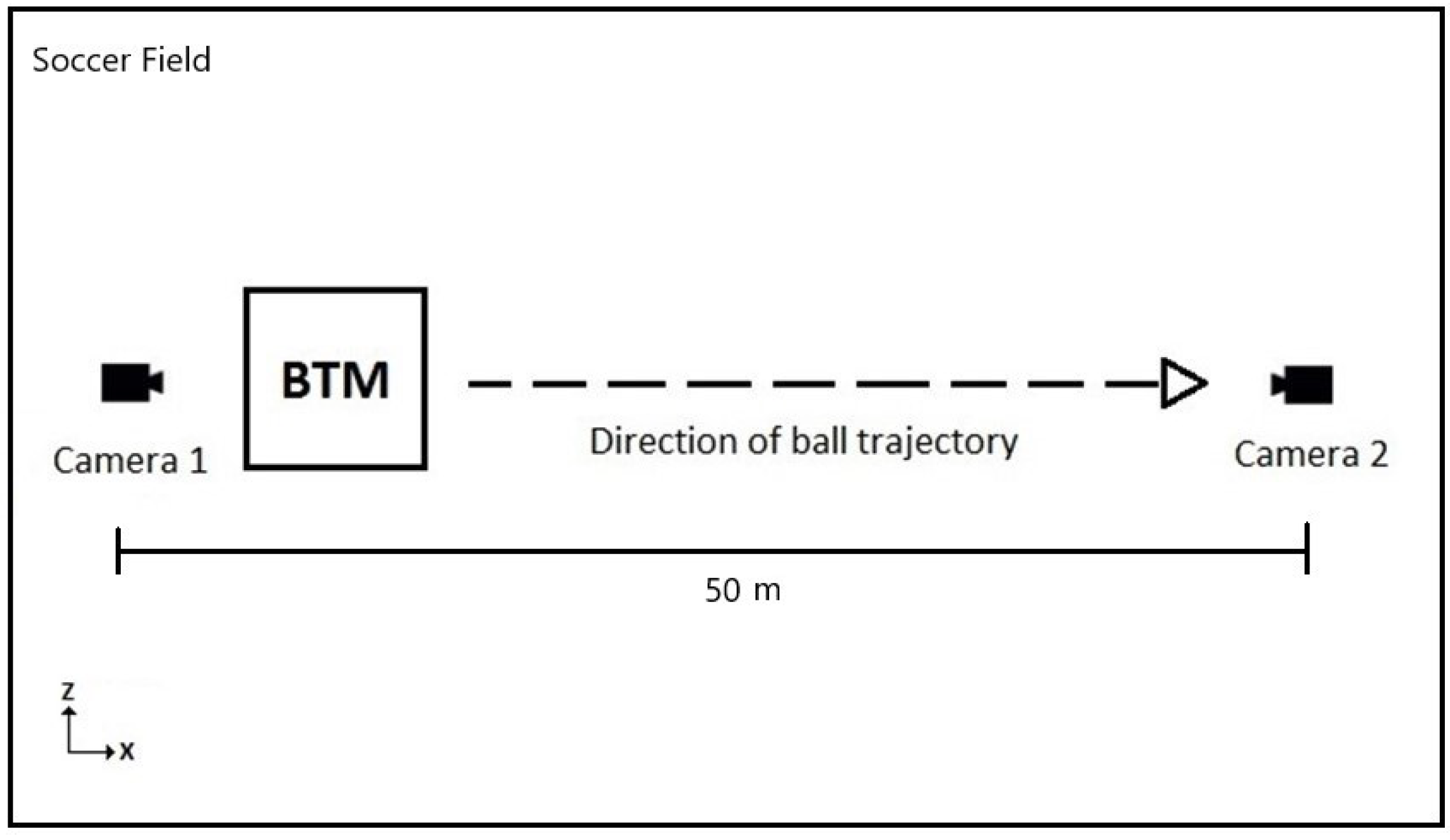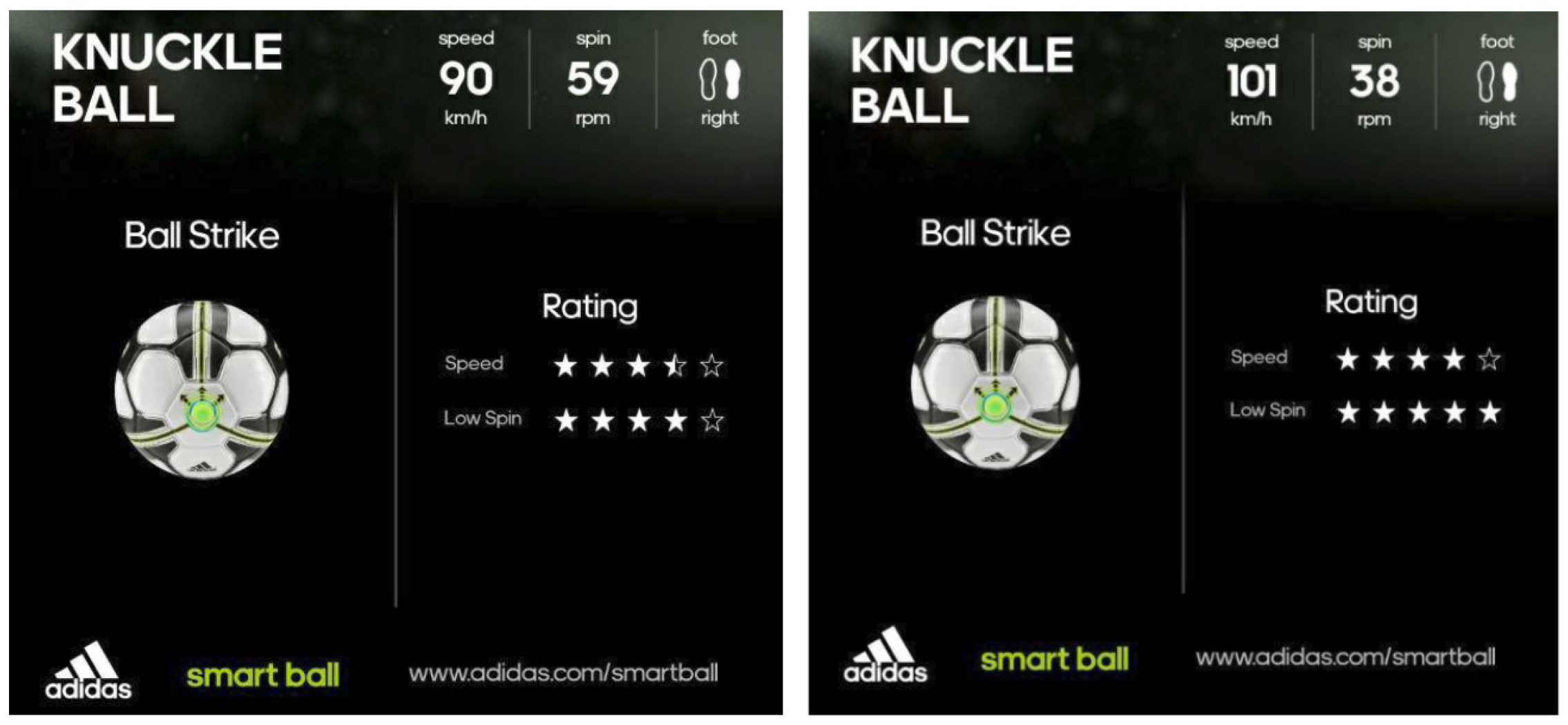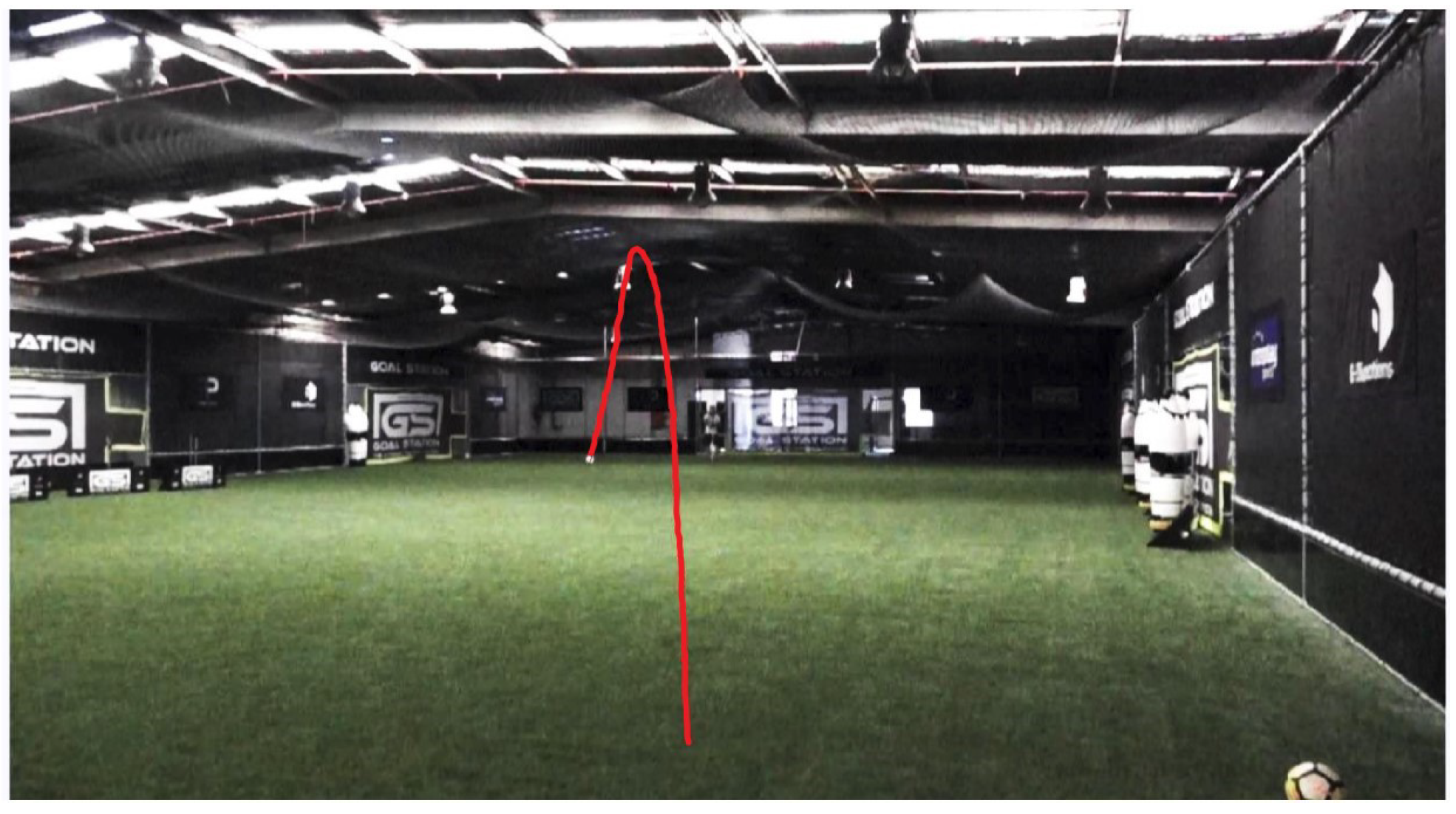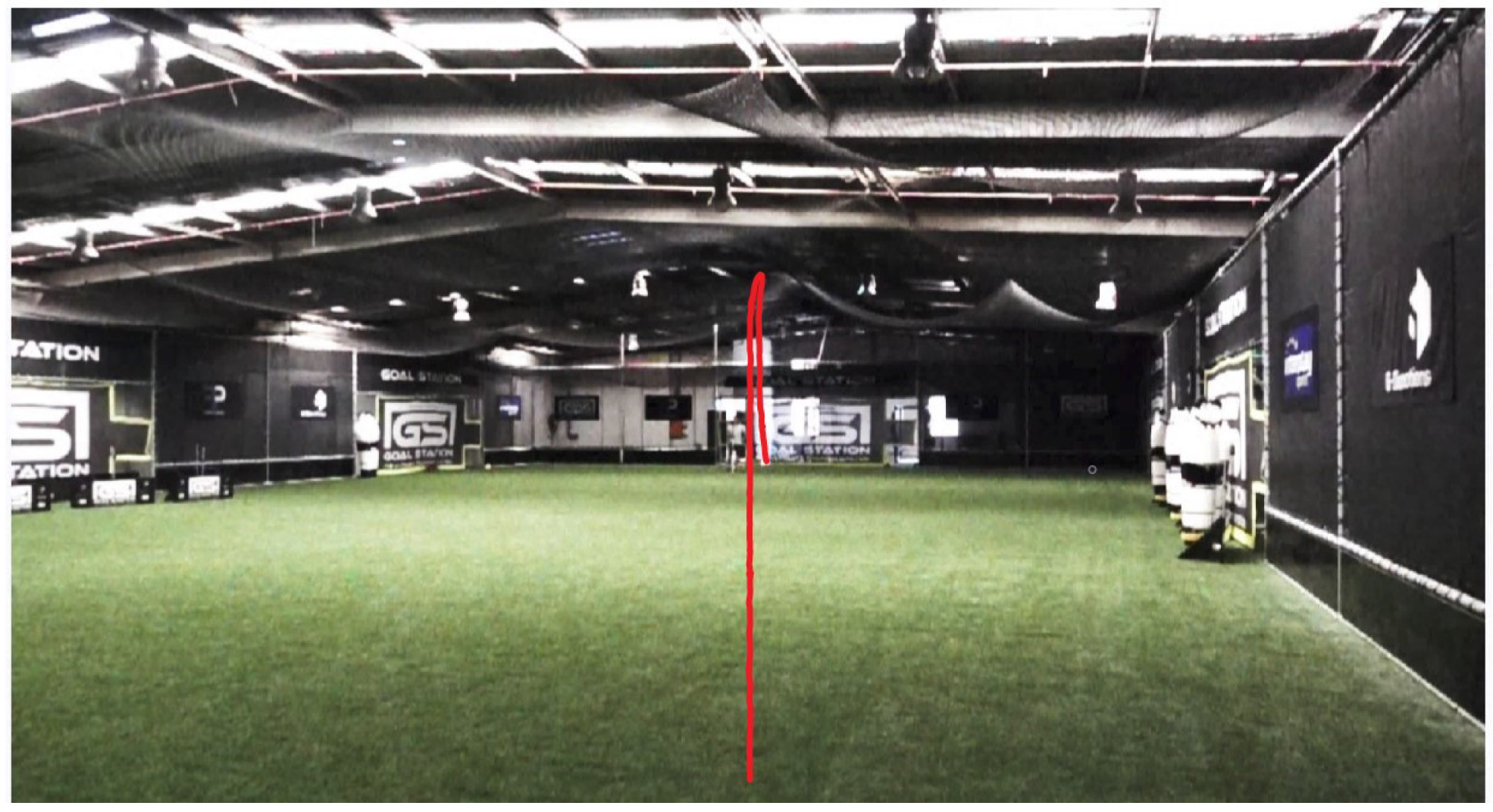1. Introduction
Throughout the history of ball sports, there have been constant developments of new techniques to manipulate the ball trajectory to create an advantage over the opposition. This often involves the application of spin to the ball which alters the trajectory of the ball due to the Magnus effect [
1,
2,
3,
4]. In the sport of Association Football (Soccer), the ability to curl the ball from both open-play and dead-ball situations (free kicks) has become a staple of the sport and is especially useful when within scoring range of the goal. If the free kick is taken from a range that has the potential to result in a goal scored directly from the kick, the defending team will often form a wall of players to obstruct a direct path to the goal and make it more difficult for the kicker to score. Given these obstacles, players will often apply different techniques when striking the ball to manipulate the trajectory of the ball in an attempt to beat both the wall and the goalkeeper. Some players may choose to attempt to strike the ball with power, while others will strike the ball with spin to curl the ball over/around the wall (the Magnus effect) [
5].
Another challenging technique incorporates minimal spin on the ball and is often used to confuse the opposition due to the erratic and random trajectory of the ball. This technique is known as the knuckleball. Knuckleballs are balls which are launched in such a way that there is minimal spin. While a spinning ball travelling through air creates a pressure differential on one side of the ball which in turn creates a force towards the direction of lower pressure, a ball travelling through air with minimal spin does not create a pressure differential—instead the surface conditions and the slow rotation of the ball generate a turbulence that varies the trajectory of the ball in an unpredictable manner [
6]. Although knuckleballs are observed at a specific window of velocities often well below the maximum observed velocity observed in the sport, the erratic and unpredictable trajectory makes it difficult for opponents to judge and defend against, which creates an advantage for those who can master the technique.
The term ‘knuckleball’ and the phenomenon itself was first observed in baseball. While it is not exactly known who first developed the technique, it is often attributed to Edward Cicotte [
7] as early as 1908. To achieve this effect, he held the ball between his knuckles, which garnered the nickname ‘Knuckles’ for himself, naming the technique ‘knuckleball’ as a result. Knuckleballs have also been observed in both soccer and volleyball [
8] and serve the same purpose in challenging the opponent.
The knuckleball was also popular in the early 1990s and 2000s due to Brazilian football star Juninho Pernambucano, but the technique did not really reach global fame until the 2010s when modern football stars, such as Cristiano Ronaldo and Gareth Bale, also used the knuckleball and brought it to the world stage. The difficulty of performing the shot, and difficulty in stopping it, make it quite a spectacle to behold when performed correctly, with Brazilian people describing it as the ‘Pombo Sem Asa’ or ‘Dove Without Wings’ [
9]. While knuckleballs have been observed in open play, they are more commonly seen from free-kick situations. This is due to the time afforded to the kicker in free-kick situations to set themselves up and prepare the correct technique required, as opposed to open-play situations where they are seldom afforded this time.
Normally, knuckleball skills are trained by repeated practice with some instructions acquired from experience. Nowadays, advanced technologies have been widely used to explore the techniques of sports. Videos are widely used to record sports actions which can then be decomposed and analysed step-by-step [
10,
11]. Other players can grasp and learn the techniques in detail by reviewing the analyzed footage. Accelerometers and inertial measurement units are used to measure the force and movement which help to understand the dynamics of a sports activity and the impacts on humans [
12,
13,
14]. We have also explored embedded-sensor-type systems in the past for robotic arm control [
15] and human posture-sensing [
16], both of which have sports biomechanics implications and the interface with humans. In the study presented in this paper, the sensors are embedded in the soccer ball and there is no human interaction to minimize human error while observing the knuckleball effect. With the help of modern sensor and measurement technologies, numerous studies have been conducted to investigate the knuckleball effect, including the ball trajectory, speed and spin characteristics, air dynamics and striking skills [
17,
18,
19].
In soccer, the design and construction of the balls are first considered where the presence of seams creates an asymmetry of flow around the ball [
20], which varies depending on the orientation of the ball, with many papers examining and validating the effect of seams on ball aerodynamics. Additionally, it has been reported that the knuckling effect has been observed on balls and objects without seams, which suggests that there are additional forces or conditions which influence the phenomenon [
8].
To conduct our research, we first needed to develop an understanding of the theoretical models of different soccer ball trajectories, especially the knuckleball effect. A phase diagram has been proposed in [
21] to categorize soccer trajectories into parabolas, straight lines, zigzag and spiral trajectories. It illustrates that ball trajectories are affected by the ratio of drag force and gravity, and the ratio of ball spin and speed. Knuckleballs have the characteristics of low spin and high speed. In [
22], two cameras were used simultaneously to record the knuckleball trajectory which comprised three-dimensional coordinates of the ball positions. Significant fluctuation was found around the top of the ball trajectory. The air drag coefficient of a soccer ball was investigated in [
23] considering two cases: dropping the ball from a high building without any initial spin and speed, and a goalie punt to generate projectile motion. The results indicated that outdoor wind and ball asymmetry had a considerable impact on the ball trajectory; thus, it was recommended that the experiment should be conducted indoors, using high-surface-quality balls.
Another important aspect of knuckleballs is the striking of the ball and the techniques and resultant dynamics associated with this [
24,
25,
26]. As demonstrated in [
27], to achieve the knuckleball, synchronized pelvis roll and yaw rotation is essential. It was also found that pelvis roll and yaw rotational angles during a knuckleball kick were smaller than these during a normal instep kick. The motions of the lower limbs and the pelvis were further researched in [
28] which concluded that the straight foot trajectory in the striking phase was important to obtain the knuckleball effect. Comparing the lower limb joint torque among different soccer kicking motions, it was found that the adduction torque of the hip joint decreased for curve kicks, while it increased for knuckle kicks [
29]. The striking points of three typical soccer kicks were researched in [
30] with the results showing that the striking point of a straight kick was located at the center area of the instep, the striking point of a curve kick was located at the low area near the inside of the foot, and the striking point of a knuckle kick was located near the foot joint.
Contact time is an important factor in ball dynamics and is determined by the location and geometry of the foot strike (which part of the foot is used and the shape and flexion of the foot) and the characteristics of the ball, such as the material, surface roughness and pressure (e.g., inflation pressure and over-pressure). Ball characteristics are governed by regulations set by the governing body, FIFA, which outlines the minimum requirements and acceptable tolerances for the ball [
31].
Research by [
32] found a weak negative relationship between contact time and ball velocity. Curled shots, or shots with high levels of spin, were found to have longer contact times as kickers attempted to maximise contact time with the ball to impart spin to it. Conversely, straight shots were found to have much shorter contact times as the kicker sought to minimise contact time to minimise any spin on the ball [
9]. Contact time for knuckleball shots would be most similar to straight shots as the kicker tries to hit the ball with minimal spin but different speed. It has been reported that some kickers will position the ball such that they will strike the bladder valve to minimise contact time. This area of the ball is relatively rigid in comparison to the rest of the ball due to the valve itself, and, as such, this face of the ball would deform to a lesser degree than other faces of the ball, thus minimising contact time.
Available research has shown that successful knuckleball shots require very precise striking of the ball and movements of the hips and ankle. To minimise the spin placed on the ball, practitioners aim to strike the ball through the centre of mass. It was found that the angle of strike for a knuckleball was 3.3 ± 0.9°, which was significantly smaller than for straight or curled shots (19.3 ± 2.4°, 32.6 ± 3.9°, respectively) [
33]. Additionally, it was determined that the characteristics of the strike for knuckling shots were more similar to curled shots than straight shots with the ankle posture and shape being flexed in similar ways at the point of impact. An analysis of the maximal torque exerted by the knee extension and hip rotation found that, while all shots had similar peak values for knee extension, the peak values for hip rotation for knuckling shots were the highest out of all the shots, (67.2 ± 6.0 Nm against 39.1 ± 3.4 Nm and 53.1 ± 5.8 Nm for straight and curled shots, respectively). This is indicative of a tendency to strike the ball with the heel pushed out towards the inside of the foot when striking a knuckling shot [
25].
From this, we can see the technical requirements of the shot executed by a player which contributes to the rarity and exclusivity of the knuckleball shot in soccer. In theory, hitting the ball along the centre of mass would ensure that the ball has no spin. However, in practice, this is not the case due to the small margin of error for the strike zone. Additionally, in an in-game situation, a human wall is erected to prevent a direct shot on goal. This means that players are required to hit the ball slightly under the centre of mass to get the ball up and over the wall. The small angle of strike leaves little room for error, with errant strikes applying some amount of spin to the ball, potentially resulting in the ball going over the bar and missing by a large margin.
This paper aims to present a comprehensive exploration of the knuckleball effect using both theoretical and experimental methods. First, the knuckleball characteristics and the main influencing factors that contribute to the knuckleball effect are explained in detail. Then, the experimental set up is described with a ball training machine and the Adidas miCoach Smart Ball. By adjusting the ball training machine actuators with different striking positions and power, knuckleballs were successfully realized in this research. In addition to use of the ball training machine, which provided ball-strike information, this research also adopted high-speed cameras to record the ball trajectory. A zig-zag trajectory was clearly observed for knuckleballs, while a smooth trajectory was observed for non-knuckleballs. Based on the fact that a knuckleball normally has low spin, investigation of the speed and spin information provided by the Adidas miCoach Smart Ball also enabled understanding of the characteristics of knuckleballs. With the help of the ball training machine, Adidas miCoach Smart Ball and cameras, the knuckleball was analysed in depth, benefiting understanding of the origin and characteristics of, and factors influencing, knuckleball.
4. Discussion
4.1. Data Analysis and Evaluation
Based on the results observed across all samples, the data was congruent with the theory found in the literature review stage of the research. Testing appeared to confirm that the thirty-two-panel design of the miCoach ball suffered minimal variances in trajectory given varying orientations of the ball. While the numerical value of the forces on the ball could not be measured, a visual inspection of the collected data was able to confirm this. As noted in the results section, while no two trajectories were the same, the majority of them followed a similar path.
The speed values of the data collected ranged from 79 to 109 km/h and averaged 94 km/h. A level of the knuckling effect was found for these shots (a minimum of one lateral direction change), with some shots exhibiting more than one directional change. This was congruent with research which found that, depending on the soccer ball used (from 2006 onwards), knuckling would begin to occur at speeds of approximately 80 km/h and higher.
At full speed, the total time for one of the recorded kicks was only 1.46 s over an approximately 50 m distance. This was far greater than the average shooting distance of the sport. In an in-game scenario, this would be the equivalent of a shot from half-way of the soccer field. Shots can range from anywhere between 0 to 35 m from the goal with typical long-range shots ranging from 15 to 30 m. While knuckleballs have comparably smaller lateral deviations than spinning kicks, the erratic nature of the kick can be enough to confuse a goalkeeper, especially given the short amount of time they may have to react.
The companion application of the Smart Ball rates each kick on a scale of five, stars as shown in
Table 1 and
Table 2. It defines an ideal knuckleball as one that experiences minimal spin (40 rpm or lower) and maximum velocity (113 km/h or higher). Throughout testing, we attempted to achieve a five-star rating for both speed and spin; however, in practice, it proved to be extremely difficult to achieve this, given the need to accurately strike the ball with sufficient power while also minimising spin. The best result was one that achieved a speed of 101 km/h and and a spin of 38 rpm (five and four stars, respectively).
The knuckleball shot was made famous by Cristiano Ronaldo, one of the most skilled soccer players in the history of the sport. Executing the skill has proven to require advanced technique, and, even with controlled methods, it is not a simple task. For beginners, it would be easier to focus on striking the ball properly and minimising the spin rather than striking for power.
Figure 12 and
Figure 13 show the typical trajectory data collected by the Tracker motion software. From
Figure 12, we can observe a typical trajectory for a ball (no knuckle effect). The figure shows that the typical shot causes the ball to veer to one side. This could be attributed to the higher spin experienced on the ball as well as the striking location of the ball. This is a much more common technique in football matches.
Figure 13 shows that the knuckleball shot exhibited a more linear path in comparison. Although there were lateral deviations observed, the ball tended to stick to a more direct trajectory. The straighter pathway can be attributed to the low spin produced by the knuckleball shot. These observations from the Tracker software verify the functions of the ball training machine and results observed from the miCoach app.
4.2. Comparing Kick Types
When comparing different techniques of kicks, there are numerous advantages and disadvantages for each style. Based on numerical calculations and physical data collection, it was found that a knuckleball performed in soccer can exhibit between one and two lateral changes in direction over a range of 30 m, which can easily leave the goalkeeper wrong-footed and unable to make a save. However, this unpredictability is also a disadvantage, as the trajectory cannot be fully controlled by the kicker and the ball may simply fly out with minimal pressure on the goalkeeper. Additionally, during testing there were attempts to produce two identical shots, but no two knuckleballs produced were the same, further exemplifying the randomness of knuckleball trajectories. Another factor is the difficulty in performing a knuckleball shot. While technological innovations have made it easier to perform knuckleballs, the technique has only been mastered by a few professional footballers.
Alternatively, players may elect to utilise a curled or driven (straight) kick. These types of kicks are more controlled in comparison, but again have their own advantages and disadvantages. Comparatively, these kicks are much easier to perform, and are staples of the game that even amateur athletes are expected to have grasped. The trajectory can be controlled depending on the amount of spin placed on the ball and the speed of the kick, which can be adjusted depending on the range of the kick. Additionally, curled and driven kicks have been observed for a range of speeds relatively higher than the range of speeds typical of a knuckleball. While these kicks travel relatively faster than knuckleballs, their trajectories are easy to understand and judge and defending them depends on judging the direction of the trajectory and reacting quickly enough.
It cannot be definitively said which technique is better than the other as each has its advantages and disadvantages. While the knuckleball can potentially be devastating, it is essentially a gamble on whether or not the shot will have the intended result. On the other hand, curled and driven shots can be considered to be more accurate as the player can aim the shot and try to place the ball away from the keeper, though the relatively straightforward trajectory means that they can be stopped more easily, subject to keeper judgement and reflexes. Ultimately, the shot selection comes down to player preference and skill, as well as the circumstances of the free kick, with the best free-kick takers able to adapt and select the right shot for the situation.
4.3. Limitations and Future Improvements
While some knuckling was achieved, the magnitude was much smaller than has previously been observed in both professional and amateur environments. These results can be attributable to numerous factors which limited the ability to produce an exaggerated knuckling effect.
The choice to use the Adidas miCoach Smart Ball for testing limited the ability to achieve an exaggerated knuckling trajectory. This was due to the technology used to construct the ball. As explored earlier, the design of the panels on a soccer ball has an impact on the trajectory due to the aerodynamic variances on the faces of the ball. A ball using the traditional thirty-two panel design minimises these variances due to the relatively symmetrical faces of the ball due to the consistent design.
Furthermore, the decision to conduct testing indoors also limited the ability to achieve an exaggerated knuckling effect. While an indoor facility created a controlled environment and eliminated various weather factors, this may have also hindered the ability to achieve the desired knuckling. The addition of wind would add a factor of randomness to the trajectory with the variances in trajectory depending on the weather conditions. It is believed that the magnitude of knuckling will vary should testing be moved to an outside space with various weather conditions.
Additionally, the design of the launcher may have affected the quality of the knuckling seen. The feeding mechanism of the launcher where the ball rolls from the rail into the tray can result in the ball not sitting in the tray uniformly each time. While most of the results collected had a similar non-identical trajectory, there were some outliers which could possibly be explained by the variances in the final position of the ball prior to being launched from the launcher. However, due to the design of the launcher, this cannot be confirmed. The use of a launcher with a different design could possibly produce different results depending on the mechanics and design, such as a design using rollers to launch the ball.
5. Conclusions
Our results demonstrated that we were successfully able to reproduce and analyze the characteristics of the knuckleball effect in soccer. The data evaluated from the miCoach Smart Ball showed that knuckleball shots maintained a low spin (rpm) with high speeds over short distances. The motion data observed through the Tracker software further confirmed the randomness of the knuckleball trajectory in comparison to a typical trajectory kick.
The growing prevalence of knuckleballs in soccer can be explained as a culmination of numerous factors. While the technique has become more popular in recent years, due to high profile players, such as Cristiano Ronaldo and Gareth Bale, adopting it, it remains a rare sight due to the difficulty in performing the shot and the benefits of other, much simpler, types of shots (e.g., curled and straight/driven shots). Obtaining an exaggerated knuckling effect requires numerous conditions to be satisfied. In addition to the absence of spin, the ball must be launched/struck at a speed which coincides with the drag crisis of the ball (the critical speed). Recent changes in the materials, design and construction of the ball has made the ball lighter and more spherical, resulting in the critical speed coinciding with the typical speeds of shots and long-range passes. However, the precise angle of strike, and the technique required, means that the knuckleball remains a rare sight in soccer.
While experimental testing was able to produce satisfactory results and to support most of the theoretical data collected, it is believed with further testing that a highly exaggerated knuckling effect can be achieved given some modifications to the testing procedure.
